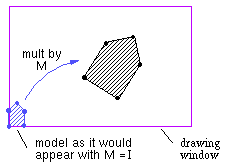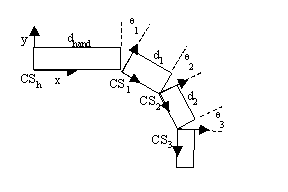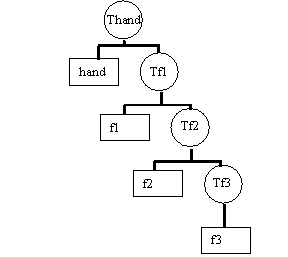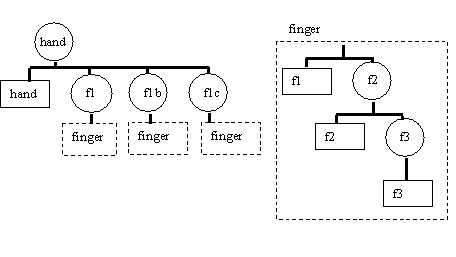

for each vertex i new_vertex_list[i] = M * vertex_list[i] scanconvert( new_vertex_list )Here is the equivalent in OpenGL:.
glBegin(GL_POLYGON); for each vertex i glVertex3fv( vertex_list[i] ); glEnd();There are several things to note:
glMatrixMode( GL_MODELVIEW ); glLoadIdentity(); glTranslatef(2.0, 1.0, 0.0); glRotatef( -3.14/2.0, 0.0, 0.0, 1.0); glScalef(2.0, 2.0, 2.0); ...which produces the matrix M = trans(2,1,0) rot(z,-90) scale(2,2,2) ....
glMatrixMode( GL_MODELVIEW ); glLoadMatrixf( M );

| f1: trans(d_hand,0,0) rot(z,th1)
f2: trans(d1,0,0) rot(z,th2) f3: trans(d2,0,0) rot(z,th3) M=M*Thand
|
 |
Now consider draw a hand with three identical fingers. We can create
a more complex scene graph which uses multiple instances of a finger scene
graph, as shown below. Because each of the fingers is defined relative
to the hand coordinate system, a way is needed to restore the hand coordinate
system before beginning to draw each finger. This is done through the pushMatrix()
and popMatrix() function calls.
| M=M*Thand
draw hand pushMatrix() M=M*Tf1a draw_finger() popMatrix() pushMatrix() M=M*Tf1b draw_finger() popMatrix() pushMatrix() M=M*Tf1c draw_finger() popMatrix() draw_finger() {
|
 |
Many graphics systems maintain a stack for the current transformation matrix: